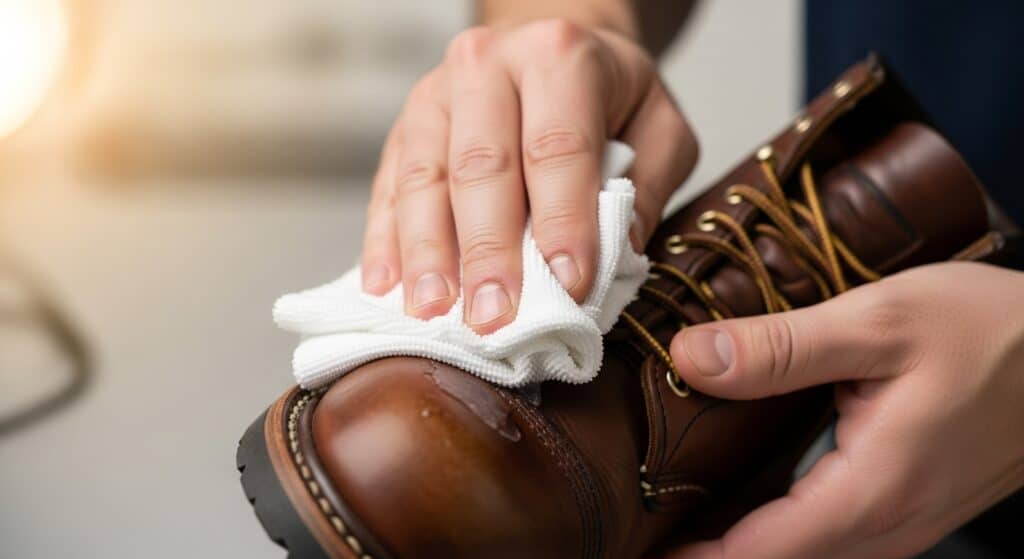If you’ve spent any time trekking through snow or icy sidewalks, you know the inevitable truth: those crusty, white salt stains are coming for your favorite boots. These stains aren’t just ugly; they’re genuinely damaging to leather.
As someone who spends a lot of time testing boot care products, I’ve seen exactly what road salt does. It pulls the natural oils and moisture right out of the leather, making it stiff and eventually leading to permanent discoloration and cracks. You need to address salt stains quickly and safely, and the good news is you probably already have the best solution sitting in your kitchen cabinet.
Here is your detailed, practical guide to safely removing salt stains from both smooth leather and delicate suede boots.








Honesty First: Why Salt is a Boot Killer
When you see that white, chalky residue, you are looking at more than just table salt (sodium chloride). Road salt often includes corrosive minerals like calcium and magnesium carbonate.
When slush and salty water get into your boots, the water evaporates, but the salt minerals are left behind. As the salt dries, it pulls the essential moisture out of the leather fibers. If left unchecked, this can lead to permanent damage:
- Discoloration and Permanent Lines: The salt residue leaves unsightly white marks that are difficult to remove once they set.
- Stiffness and Cracking: The loss of moisture causes the leather to become brittle and crack prematurely.
- Blistering: If the salt water soaks deep into the leather and then dries, the salt crystals can re-crystallize beneath the surface, physically pushing out and blistering the leather.

removing salt stains from work boots
The Golden Rules: What NOT to Do
Before you grab a cleaning supply, know these non-negotiables. Following these rules prevents catastrophic damage:
- Never Use Direct Heat for Drying: Do not put wet or cleaned boots near a radiator, fireplace, or use a hairdryer. Rapidly drying leather causes it to shrink, warp, and become brittle.
- Never Use Harsh Cleaners: Avoid common household products like dish soap, detergents, bleach, or ammonia, as they will strip the protective finishes and necessary oils from the leather.
- Never Apply Conditioner or Wax Over Stains: If salt is still present, applying polish or oil will encapsulate the salt within the leather, meaning the drying and corrosive damage will continue underneath.
- Use Saddle Soap Sparingly: Saddle soap (like Fiebing’s) is excellent for heavy-duty cleaning, but it is an astringent that removes oils. If you use it, conditioning afterward is absolutely essential.
Your Toolkit for Salt Removal
For a safe and effective clean, you likely have everything you need right now:
- Distilled White Vinegar
- Cool, Clean Water
- A Small Bowl
- 2-3 Clean, White, Lint-Free Cloths (or cotton balls)
- A Suede Brush or old clean toothbrush (for suede only)
- A Leather Conditioner of your choice (for leather only)
Method 1: Smooth & Oiled Leather Boots
This is the standard, pro-approved way to fix most salt issues on leather work boots (like Red Wings, Thorogood Moc Toes, or Timberlands). The secret is the vinegar solution, which uses mild acid to neutralize the alkaline salt minerals.
Time Commitment: 10–15 minutes of active work, followed by 24–48 hours of hands-off drying time.

smooth leather
Step-by-Step Guide for Smooth Leather
- Prep and Wipe: Ensure your boots are dry. Use a soft cloth or brush to wipe away any loose dust or crusty salt residue from the surface.
- Mix the Solution: Mix white vinegar and cool water in a bowl. A 1-to-1 ratio is common and effective. (You can use 2 parts water to 1 part vinegar if you’re concerned about sensitive leather).
- Test the Leather: Always test the solution on a hidden spot first (like the inner heel) to ensure it doesn’t cause discoloration.
- Clean the Stain: Dip a clean cloth into the solution, wring it out so it is only damp, and gently wipe or rub the salt-stained areas. You should see the stain disappear.
- The Critical Blending Wipe: This step prevents ugly water rings. Take a new, clean cloth and dampen it with just plain water. Wipe the entire boot (or the entire panel where you used the vinegar) with this cloth. This evens out the moisture and removes any lingering vinegar, ensuring a uniform drying process.
- Dry Naturally: Remove the laces and any insoles. Stuff the boots tightly with newspaper to absorb moisture and help the boots hold their shape. Let the boots air dry completely at room temperature for at least 24 hours, away from all heat sources.
- Condition (Non-Negotiable): Once your boots are 100% dry, they will be thirsty. You must apply a quality leather conditioner to restore the essential oils stripped by the salt. This keeps the leather supple and flexible.
Recommended Conditioners for Leather Boots:
- Best Overall Pick: Venetian Leather Balm balances deep conditioning with weather resistance and—crucially—doesn’t darken the leather significantly.
- Best for Waterproofing: Obenauf’s Heavy Duty LP is heavy on beeswax and adds a ton of water resistance, making it great for true work boots, but expect it to permanently darken the leather.
- Budget Pick: Bick 4 is affordable and won’t darken the leather at all. However, it doesn’t penetrate as deeply or add much water resistance, so you may need several coats.
- For Deep Restoration: If your leather is seriously dried out, Leather Honey penetrates deep, but it will darken the leather somewhat.
Method 2: Suede & Nubuck Boots (The Delicate Process)
Suede has a napped finish that is less durable and hates water; soaking it can lead to discoloration. This process requires more patience and minimal moisture.

suede & nubuck boots
Step-by-Step Guide for Suede
- Dry and Brush: Ensure the boots are 100% dry. Use a specific suede brush (or an old clean toothbrush) to gently brush off any loose salt or dirt. This action may be all you need to lift the salt.
- Erase the Stain: Use a suede eraser on the stain lines. This helps remove smaller embedded dirt and may lift the white mark.
- Vinegar Solution (If Necessary): If the stain persists, mix a diluted water and white vinegar solution (1 part vinegar to 1 part water). Dip a soft cloth or cotton ball into the solution and wring it out so it is barely damp.
- Blot, Don’t Rub: Gently blot the salt-stained area until the stain lifts. Do not rub aggressively or saturate the material.
- Air Dry & Restore Nap: Allow the boots to air dry naturally, away from heat. Once completely dry, use the suede brush to gently brush the material again, which restores the fuzzy texture (the nap).
- Protect: Finish by applying a protective spray specifically designed for suede and leather to guard against future stains.
Prevention is the Best Defense
The best way to deal with salt stains is to stop them before they start.
- Daily Maintenance: Wipe down your boots with a cloth dampened with plain water as soon as you get home after walking on salted surfaces. This removes the salt before it has time to seep in and dry.
- Waterproofing Before Winter: Before the snow and salt appear, treat your clean, dry boots with a high-quality weatherproofing product.
- For smooth leather, use a heavy-duty wax (like Sno-Seal) or a wax-based conditioner (like Obenauf’s LP) to create a protective barrier.
- For suede and nubuck, only use a high-quality spray labeled specifically for those materials. Reapply this protective spray every few weeks in heavy use.
- Proper Drying Technique: If your boots get soaked, always let them dry slowly and naturally, stuffing them with newspaper to absorb moisture and maintain their shape. Never place them near direct heat sources.
Frequently Asked Questions (FAQ)
Here are the common questions we get about dealing with stubborn salt stains:
Why does white vinegar work on salt stains?
It’s simple chemistry. The salt from roads is alkaline. Vinegar is a mild acid. The vinegar safely dissolves and neutralizes the salt minerals without the harsh, oil-stripping effects of soap.
Will vinegar damage or smell up my boots?
No, not if you follow our guide. By diluting it (1-to-1 or 2-to-1 with water) and re-conditioning, the process is safe. The vinegar smell will disappear completely as the boots dry. The most important step is to re-condition your leather boots after they are dry, as the process does remove some natural oils.
Can I use a commercial “salt stain remover” product?
Absolutely. Products from brands like Saphir, Angelus, or Fiebing’s work very well. However, their primary active ingredient is often a mild acid, just like vinegar. The vinegar solution works just as well and costs pennies.
The salt stain is gone, but now I have a dark water ring. What do I do?
This is common, especially on suede or lighter-colored leather. It means the “blending” wipe (Step 5) wasn’t even. To fix it, you need to re-dampen the entire boot (or the entire panel) with a clean, damp cloth so it dries uniformly. Let it dry completely, then re-condition (for leather) or re-brush (for suede).











